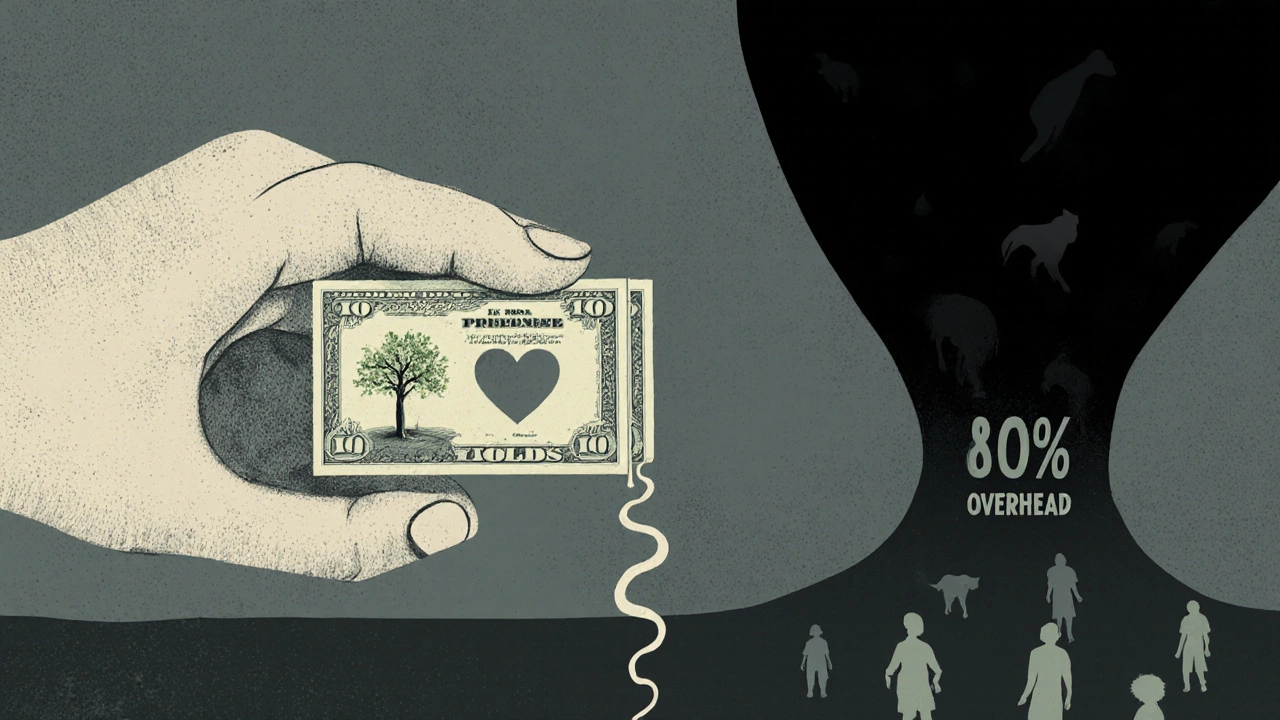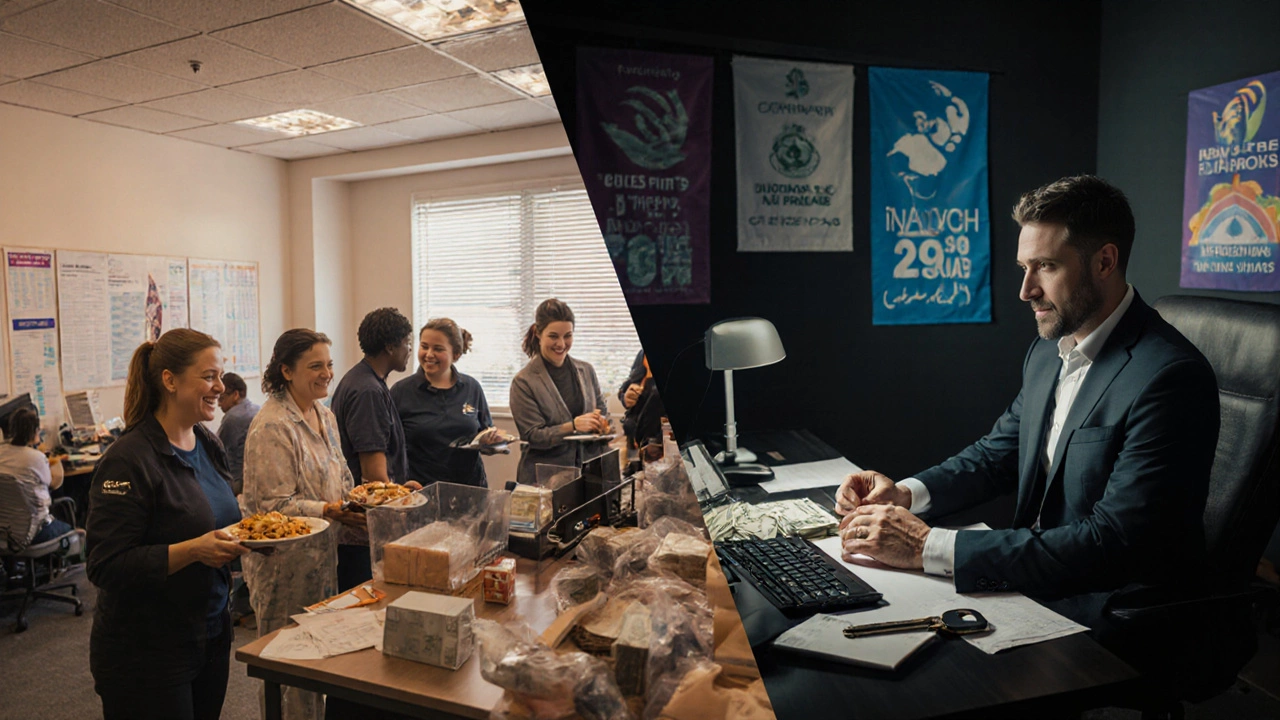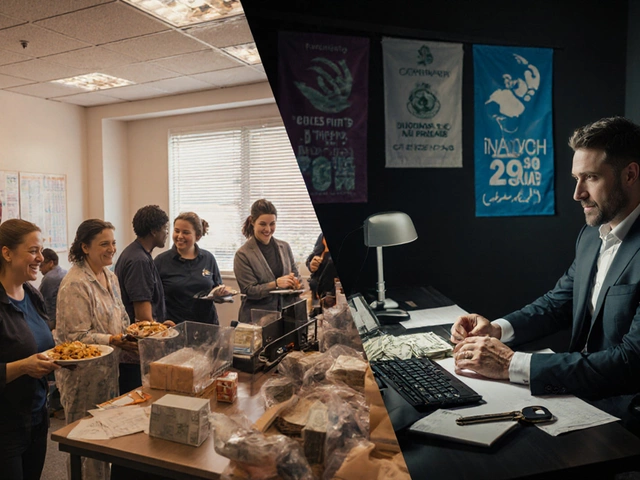Charity Transparency Checker
Check Charity Transparency
Every year, people in New Zealand and around the world give millions to charities hoping to make a difference. But not every organization with a heartfelt story is doing good work. Some are outright scams. Others are well-meaning but waste most of your money on overhead, salaries, and flashy marketing. If you’ve ever wondered which charities are rip-offs, you’re not alone. And you’re right to ask.
How do fake charities trick people?
Fake charities don’t always look fake. They use emotional photos of children, dogs, or disaster victims. They send texts that say "Your donation saved a life today." They show up at doorsteps with clipboards and ask for cash. Some even have websites that look professional, with domain names like "saveourplanet.org" or "helpthekidsnow.org."
But here’s what they don’t tell you: 80% of the money might go to the people running the charity, not the cause. In 2024, the Australian Charities and Not-for-profits Commission found that 12% of registered charities spent less than 50% of their income on programs. Some spent under 20%. That’s not inefficiency-that’s exploitation.
One common trick? Name confusion. A scammer might call their charity "The New Zealand Children’s Foundation," hoping you’ll mix it up with the real "New Zealand Children’s Trust." They’ll use similar logos, similar colors, even similar phone numbers. You give $50, thinking you’re helping kids. The money goes to a luxury car and a vacation in Bali.
Red flags that a charity might be a rip-off
Here are the top five warning signs you can spot right away:
- They pressure you to donate right now. "This offer expires in 24 hours!" Real charities don’t use countdown timers. They’re not selling concert tickets.
- No clear financial info online. If you can’t find their annual report, tax filings, or how much they spend on programs, walk away. Legit charities publish this openly.
- They only accept cash or gift cards. Cash is untraceable. Gift cards? That’s how scammers launder money. Always pay by credit card or bank transfer-you can dispute it if something’s wrong.
- The name sounds too generic. "Help the World," "Save the Animals Now," "Charity for Everyone"-these are red flags. Real organizations have specific names tied to real places or causes.
- No physical address or phone number. If their website only has a contact form and a PO box, that’s a problem. Legit charities have offices, staff, and public contact details.
How to check if a charity is real
In New Zealand, every registered charity must be listed on the Charities Services website run by the Department of Internal Affairs. Go to charities.govt.nz and search by name. If it’s not there, it’s not registered. That doesn’t mean it’s illegal-but it means you have zero legal protection if things go wrong.
Look at their financial statements. You’ll see three key numbers:
- Program expenses: What percentage goes directly to the cause? Aim for 75% or higher.
- Administrative costs: Salaries, rent, utilities. Under 15% is good. Over 25% is worrying.
- Fundraising costs: How much did they spend to collect donations? If it’s more than 20%, they’re spending more to raise money than they are to help people.
For example, the St. Vincent de Paul Society is a well-known New Zealand charity that provides food, housing, and emergency aid to people in need. In their 2023 report, 82% of funds went to programs. Only 12% went to administration. That’s solid.
Compare that to a charity called "Pacific Rescue Network," which claimed to help island communities after cyclones. Their financials showed 68% went to fundraising, 18% to admin, and only 14% to actual aid. They shut down in 2024 after an investigation.

Top 3 charities in New Zealand that have been flagged
Not all flagged charities are scams. Some are just poorly run. Here are three that have drawn criticism in recent years:
- Global Aid Foundation - Promised to send clean water to Pacific islands. But their 2022 report showed they spent $210,000 on a marketing campaign and only $47,000 on actual water filters. They’ve since restructured, but many donors walked away.
- Animal Welfare Trust NZ - Ran ads showing abused dogs with a phone number to call. Turns out, they didn’t operate any shelters. They paid a third-party vet clinic to take in a few animals, then kept the rest of the money. The Charities Services revoked their registration in early 2025.
- Hope for Youth NZ - Claimed to support homeless teens. Their CEO made $185,000 a year. The charity had no youth outreach staff. Only two part-time workers. They were found to be using donations to fund luxury travel and a second home. The case is still under review.
These aren’t the only ones. But they’re examples of what happens when oversight is weak and donors don’t ask questions.
What to do if you’ve already donated to a shady charity
If you gave money to a charity that later turned out to be questionable, here’s what you can do:
- Check if they’re registered on charities.govt.nz. If not, report them.
- If you paid by credit card, contact your bank. You can dispute the charge within 120 days.
- File a complaint with the Commerce Commission at comcom.govt.nz. They track fraud and can investigate.
- Share your experience. Tell friends. Post on community forums. Scammers thrive in silence.
Don’t feel guilty for being suspicious. Being careful isn’t being cold-hearted. It’s being smart.
Where to donate with confidence
Not all charities are scams. Many are doing incredible work with transparency and integrity. Here are three New Zealand charities with strong track records:
- Salvation Army Provides food banks, emergency housing, and addiction support across the country - 84% program spending, audited annually.
- Red Cross New Zealand Responds to disasters, supports refugees, and runs blood donation services - 87% program spending, fully transparent financials.
- Women’s Refuge Helps women and children escaping domestic violence - 81% program spending, public annual reports since 2010.
These organizations don’t hide their numbers. They publish them. They welcome questions. They let you see where your money goes.

How to donate smarter
Here’s a simple checklist to use before you give:
- Search the charity on charities.govt.nz.
- Look at their latest annual report. Find the program spending percentage.
- Check if they list a physical address and phone number.
- Don’t give cash. Use a traceable method.
- Ask: "What specific problem does this charity solve, and how do they measure success?" If they can’t answer, walk away.
Also, consider giving to local groups. A community food bank in your suburb might not have a fancy website, but they’re feeding real people. You can visit them. Talk to the volunteers. See the work yourself. That’s harder to fake.
Why this matters beyond your money
When you give to a scam, you’re not just losing cash. You’re hurting real charities. Donors get burned. They stop giving. That means fewer resources for the groups that actually need help. It’s a ripple effect.
And when you give wisely, you’re not just helping one cause-you’re strengthening the whole system. You’re telling honest organizations: "We see you. We trust you. We support you."
Don’t let fraud silence your generosity. Be informed. Be cautious. But don’t stop caring.
How do I know if a charity is registered in New Zealand?
Go to charities.govt.nz and search the charity’s name. Only organizations registered with Charities Services are legally allowed to raise money as a charity. If it’s not there, it’s not registered-and you have no protection if things go wrong.
What percentage of donations should go to the cause?
Aim for charities where at least 75% of funds go directly to programs. Anything below 60% is a red flag. The rest should be split between administration (under 15%) and fundraising (under 20%).
Can I get my money back if I donated to a fake charity?
If you paid by credit card, you can dispute the charge within 120 days. For bank transfers or cash, recovery is unlikely. That’s why checking before you donate is so important. Always use a traceable payment method.
Are charities that call or text me trustworthy?
Not necessarily. Many scams use cold calls or texts to pressure you into giving. Real charities will never demand immediate payment or threaten you with consequences if you don’t donate. If they do, hang up or delete the message.
Should I donate to charities that help overseas?
Yes-but only if they’re transparent. International charities must still register in New Zealand if they raise money here. Check their financials. Ask how much of your donation actually reaches the people. Some local groups partner with overseas organizations, which can be more efficient than sending money abroad.
What to do next
Before you donate again, take five minutes. Go to charities.govt.nz. Type in the name. Look at the numbers. Talk to someone who works there. If it feels right, give. If it feels off, walk away.
Your money matters. So does your trust. Protect both.


